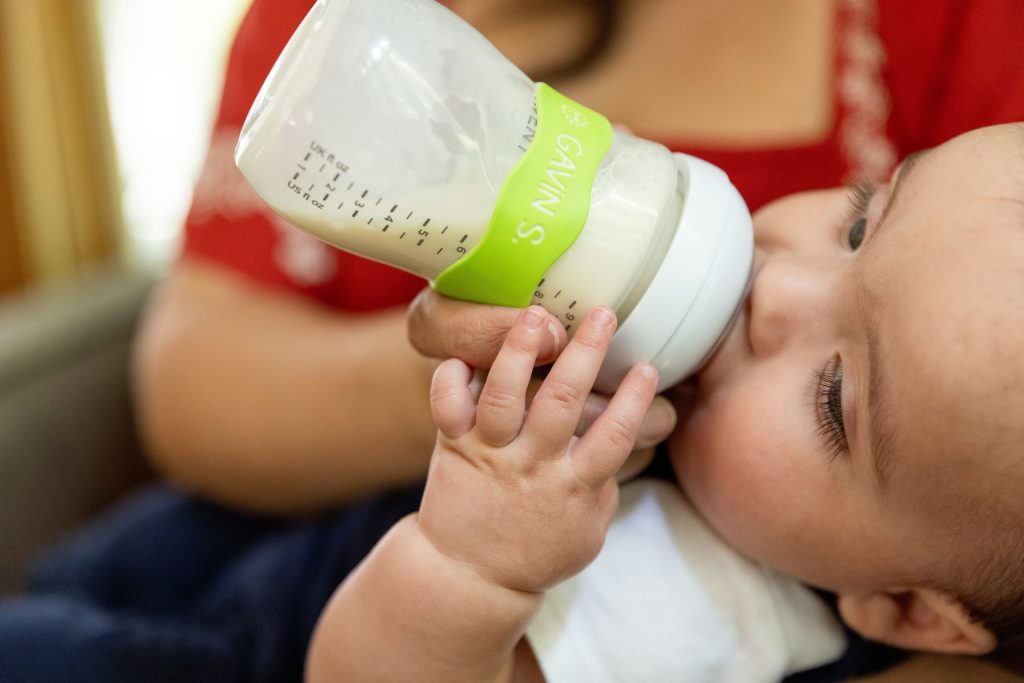There’s a lot of research before choosing the best diet for your infant, especially regarding baby formulas. Every mother wants to use the best baby formulas for her little ones. So, it often gets pretty overwhelming with all the choices that can be found online.
That’s precisely why I have written this article, to help all the mothers out there get the information they need before making the right decision. So, how is baby formula made? Continue reading to discover all there is to know about it!

How Is Baby Formula Made
Baby formula is produced from special dried-milk powder, making it a safe alternative to breast milk. It’s usually made from a natural source of milk, like cows, rice, or soybeans, plus the needed minerals and vitamins.
Furthermore, it includes fat from vegetable oils, which support the baby’s growth. To prepare it, mix the powder with boiled water and feed it to the infant with a cup or bottle.
While many companies showcase unique ingredients, the formulas usually contain the same basic components.
Although there are 30 necessary nutritional elements, including vitamins and minerals, the three main groups are fats, proteins, and carbohydrates.
Moreover, the most important goal is for the infants to receive adequate nourishment in a secure formulation.
That’s why the added nutrients are meant to support your baby’s growth during their first six months. Only after can the newborn begin consuming solid food as well.
Nutritive demands in baby formulas
The required components of the formulas are applied by the Codex Alimentarius, supervised by the Food and Agriculture Organization of the United Nations and WHO.
The FDA demands that all formulas have between 0.15 to 3.0 mg of iron per infant-sized serving (100 kcal).
Regarding the other components, the formula should contain 1.8–3.0 grams of protein, 9.0–14.0 grams of carbohydrates, and 4.4–6.0 grams of fat. So, let’s see the different types, now that you know: how is baby formula made?
Types of Baby Formulas
There are three main types of baby formulas: milk protein-based, soy-based, and protein hydrolysate formulas.
Milk protein-based
The most common baby formula is the one based on cow’s milk. It’s made to resemble breast milk and has the right balance of nutrients, making it easy to digest. This includes iron, minerals, vitamins, and vegetable oils.
Healthy full-term babies who are not breastfeeding should always start with this formula before trying any other type. However, it’s important to note that a baby isn’t supposed to drink regular cow’s milk until 12 months of age.
Remember that some babies may also be allergic to the proteins in cow’s milk. That’s when the soy-based and protein hydrolysate formulas step in. They are altered for those babies who cannot tolerate lactose or cow’s-milk protein, making them easier to digest.
Read more: How to Make Baby Oatmeal

Soy-based
Soy-based formulas are used for babies who are intolerant or allergic to lactose, a carbohydrate naturally found in cow’s milk.
As the name implies, they are made from soybeans, added nutrients, and vegetable oils. They represent 12% of the formula market, and it’s thought to possibly help relieve gas, fussiness, or colic.
Protein hydrolysate and specialized formulas
If your baby is allergic to cow and soy milk, the best alternative is a protein hydrolysate. These formulas may also be the best choice for babies with digestive, gut, or malabsorption problems, including a food protein allergy. The protein hydrolysate formula is made of broken-down or hydrolyzed protein.
Specialized formulas are also made for premature infants and babies with specific medical problems. They are often used for specific cultural or religious reasons as well. However, these formulas should only be used after you’ve consulted a healthcare professional.
Common specialized formulas
Some more notable specialized formulas are a starter, anti-reflux, and formulas with added compounds.
Starter formulas are meant for babies under six months and require follow-up formulas after they have reached the appropriate age due to the higher iron content.
Anti-reflux formulas are designed to help keep the milk in the baby’s stomach and reduce reflux by adding thickener.
Formulas with added compounds include common additives such as prebiotics, probiotics, antioxidants, and long-chain polyunsaturated (LCP) acids, making them more similar to breast milk.
However, this doesn’t mean that your baby will absorb these compounds in the same way as if they were breastfed.
Difference Between Breast Milk and Baby Formulas
Even though baby formulas are a nutritionally complete food for babies, they still aren’t the same as natural breast milk.
There is one main difference that first stands out between breastmilk and baby formulas. It lies in the natural antibodies that breast milk contains. These antibodies are used to prevent various illnesses that may harm your baby, protecting it from them.
The second difference is in nutritional value. As time passes, the nutrition in breast milk adapts, making it more suitable for your baby. This isn’t the case with baby formulas. Their nutritional contents stay the same no matter how much time has passed.
The third difference you should be aware of is the amount of protein. It’s safe to say that the mother’s milk has significantly less protein than the baby’s formula.
Some studies have shown that protein plays a key part in preventing your baby from becoming overweight or developing obesity as they grow older. So, if you want to reduce this risk, try finding a formula that contains less protein.
Also read: How to Sit When Pumping Breast Milk
Conclusion
After explaining the process behind the production of baby formulas, I hope it’s easier to grasp the different types of formulas out there.
Knowing how they are made will make a lot of difference when deciding which one to try. The one thing left for you to consider is to read the label on the formula to ensure it’s appropriate for your baby’s age.
So, how is baby formula made, and is it safe for your baby? I hope you have all the information to answer the questions by reading this article.
All that’s left is to decide which product best suits your baby and try it. However, remember that you should always consult with a professional!








